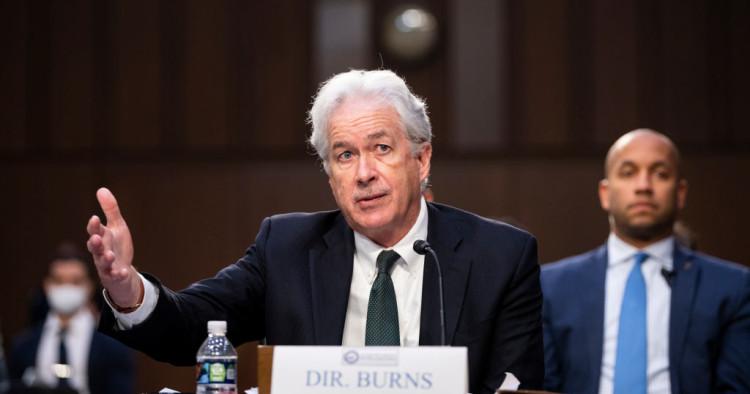Contents:
- The Biden administration’s latest tactical adjustments to its Gaza war response
- As Israel-Hezbollah tensions heat up, is a diplomatic solution possible?
- "Lavender" and mounting evidence of Israeli use of AI in target acquisition
The Biden administration’s latest tactical adjustments to its Gaza war response
Brian Katulis
Senior Fellow for US Foreign Policy and Senior Advisor to the President

-
Recent events in Gaza, including a strike that killed seven foreign aid workers, have resulted in shifts in US policy that are driven more by events in the region than by any domestic political pressure.
-
The Biden administration continues to increase its focus on humanitarian aid and civilian protection in Gaza, even as its strategic priorities remain centered on defending against security threats posed to the United States, Israel, and other regional partners.
Central Intelligence Agency (CIA) Director Bill Burns is in the Middle East once again to coordinate the United States’ diplomatic efforts with key regional partners in the protracted negotiations to achieve a temporary cease-fire and hostage release in the Gaza war, which just passed the six-month mark.
A deal for a pause in the fighting combined with a release of hostages held by Hamas in the Gaza Strip has been a top priority for US policy for several months now. As the human security situation has grown increasingly dire for Palestinians in Gaza, several top Biden administration officials have tried to open up new corridors for aid and increase civilian protections. In visits to the region over the past few weeks, leading officials like Secretary of State Antony Blinken and others have made this a priority.
Tensions between the US and Israel over humanitarian aid to Gaza have been growing for quite some time, mostly behind the scenes; but last week’s deadly strike on World Central Kitchen workers shone a glaring spotlight on this bilateral rift. The attack appears to have galvanized some quick policy shifts on the humanitarian aid issue, including the opening of new humanitarian aid corridors by Israel, after US President Joe Biden and Israeli Prime Minister Benjamin Netanyahu spoke on the phone last week.
But it remains to be seen whether these shifts will be significant enough to address the enormity of the human security challenges unfolding among ordinary Palestinians in Gaza. Since the start of the war, the Biden team has put forward several policy objectives, and some of the tactics it has used to achieve progress toward those objectives have been at odds with one another. The top US policy priorities clearly have been supporting Israel’s self-defense and its effort to eliminate Hamas as a security threat, along with trying to avoid a wider regional war. The objectives of ensuring civilian protection and humanitarian aid into Gaza were heretofore relegated to a lower priority relative to those other goals, as was the longer-term goal of creating a framework for a two-state solution. But now, US policy may have entered a new phase where the Palestinian people of Gaza, caught in the crosshairs of conflict, receive greater attention.
A lot continues to hinge on whether the ongoing diplomacy to achieve a cease-fire and hostage release produces results. That’s where the centerpiece of the struggle to achieve actual results lies — in the discussions between the main combatants to the war, and not in United Nations resolutions or in public demonstrations or political advocacy efforts on the streets of America or Europe.
A big question that continues to loom is what Israel conceives for the next phase of its military operations to eliminate the threat posed by Hamas. Last week, top US and Israeli officials met to discuss Israeli plans for an operation in Rafah, the southern part of the Gaza Strip where more than 1 million Palestinians have sheltered since the start of the war. Biden officials have expressed concerns about what they see as the lack of a clear plan to conduct operations in a way that keeps Palestinian safe.
More broadly, the war is taking place at a time in the region when threats posed by Iran and its network of regional partners in Lebanon, Syria, Iraq, and Yemen loom large and worries persist about a wider regional conflagration. The Biden administration has stepped up efforts to influence and impact the trajectory of events on the ground not just in Gaza but also in the wider Middle East, yet events remain driven by the decisions and actions of a multiplicity of actors in the region.
Follow: @Katulis
As Israel-Hezbollah tensions heat up, is a diplomatic solution possible?
Randa Slim
Senior Fellow and Director of Conflict Resolution and Track II Dialogues Program

-
The increasing intensity of the fighting between Hezbollah and Israel and the rhetorical escalation between officials seem to be paving the way for a large war, but the two sides understand that such a war would have tremendous consequences for the civilian population in both countries.
-
There are two factors that could complicate a diplomatic solution: The expected Iranian retaliation against Israel and the latter’s reaction to it, and the fate of the ongoing indirect negotiations between Hamas and Israel over a cease-fire deal and hostage/prisoner release.
According to Israeli officials, border clashes between Israel and Lebanon have been intensifying and widening. Israel has stepped up its strikes deeper inside Lebanese territory as well as against Iran-linked targets in Syria, including an airstrike against the Iranian consulate in Damascus on April 1. In his April 5 speech, Hezbollah Secretary-General Hassan Nasrallah said that border clashes with Israel will continue, and reiterated that Hezbollah will not stop its attacks until the war in Gaza ends. Furthermore, Nasrallah said that Lebanon should prepare for the aftermath of an inevitable Iranian retaliation against Israel, and underlined that Hezbollah does not fear an escalation on the border should that happen, warning that the group has not used its main weapons yet.
On April 7, the Israeli army announced on its website that it had completed “another phase of the Northern Command’s readiness for war” on the Lebanon front. Increasingly, analysts are arguing that the longer the border clashes continue, the more likely it is that a broad war will ensue involving a ground invasion of south Lebanon. Such an invasion would be aimed at creating a security corridor deep into Lebanese territory that would push Hezbollah fighters north of the Litani River. Israel’s last experiment with establishing a security corridor in south Lebanon, from 1985-2000, did not end well, and it is unlikely that a new attempt will succeed in satisfying Israel’s desire for stability on its border with Lebanon. Despite Israeli political and military officials’ past reservations about engaging in ground combat in Lebanon again, Amos Harel argues that “against the backdrop of the shift in attitude toward ground combat, a scenario of a general war in Lebanon no longer seems unfounded.”
There are two factors that Israeli officials should weigh in their decision-making calculus about a full-blown war with Hezbollah. First, if such a war were to be launched, all the other members of the Iran-led “Axis of Resistance” would likely join the fight against Israel and the US. Second, the Biden administration has made its opposition to a significant escalation in Lebanon clear. An Israeli decision to launch such a war at a time the US president is calling for an immediate cease-fire in Gaza and raising serious objections about an Israeli ground incursion in Rafah will add even greater friction to an already stressed bilateral relationship.
On the one hand, the increasing intensity of the fighting between Hezbollah and Israel, which according to the Israeli military is “more than what is taking place in Gaza,” and the rhetorical escalation between Israeli and Hezbollah officials seem to be paving the way for a large war between Israel and Lebanon. On the other hand, both Israeli and Hezbollah officials understand that such a war will have tremendous consequences for civilians in both countries at a time when war weariness is already starting to set in. Moreover, it is not clear to Israeli officials whether another war with Hezbollah will end any differently than the 2006 war did; that conflict resulted in UN Security Council Resolution (UNSCR) 1701, which was never implemented by either side.
UNSCR 1701 calls for militants that do not belong to the Lebanese army or the UN Interim Force in Lebanon (UNIFIL) to withdraw roughly 25 miles north of the Israeli border. UNSCR 1701 also calls for Israel to withdraw from occupied Lebanese territory and for Israel to stop violating Lebanese airspace.
To date, Lebanese officials, Hezbollah leaders, and Israeli officials have all indicated their preference for a diplomatic solution to the ongoing conflict on the border. Hezbollah has conditioned its approval of any agreement on the cessation of fighting in Gaza.
The US has proposed a roadmap for resolving the ongoing conflict involving a series of security arrangements that would address the two sides’ respective demands while falling short of a full implementation of UNSCR 1701. This would entail Hezbollah withdrawing its troops, particularly its elite Radwan Forces, north of the border to the Litani River and the Lebanese army and UNIFIL increasing their presence in the area vacated by Hezbollah militants. In addition, the US would engage in a mediation effort between the two sides to resolve disputes over their land border, along the lines of its successful mediation effort on the maritime border.
There are two factors that could complicate the future of a diplomatic solution to the ongoing Hezbollah-Israel conflict:
- The expected Iranian retaliation against Israel and the latter’s reaction to it. If Israel responds by targeting Iranian assets inside or outside Iran, then Hezbollah and the other members of the Axis of Resistance will escalate their attacks on Israel, thereby increasing the chances of a full-blown war between Israel and Lebanon.
- The fate of the ongoing indirect negotiations between Hamas and Israel, mediated by Qatar, Egypt, and the US, over a cease-fire deal that would release Israeli hostages held by Hamas and Palestinian prisoners in Israeli jails. If these negotiations prove successful, Hezbollah will also abide by the cease-fire agreement and there will be new momentum for the US to relaunch its mediation effort between Israel and Lebanon.
Follow: @rmslim
“Lavender” and mounting evidence of Israeli use of AI in target acquisition
Vincent Carchidi
Non-Resident Scholar

-
The Israel Defense Forces’ (IDF) intention to leverage machine learning and data science for accelerated target acquisition during conflicts has been explicit since at least 2019.
-
Its reported use of the artificial intelligence models “Lavender” and “The Gospel” in Gaza is consistent with heightened momentum for accelerated target acquisition aided by advanced technologies; although their use does not necessarily indicate greater accuracy in selecting targets.
The Israel Defense Forces (IDF) make no secret of their desire to acquire targets more efficiently. The General Staff Targeting Directorate was established in 2019 with the express purpose of linking data science and machine learning for target acquisition, spurred by concern that the Israeli Air Force faced a “shortage” of militarily valuable targets in previous conflicts. To that end, it was reported late last year that an artificial intelligence (AI) system called “Habsora” (in English, “The Gospel”) vastly accelerated the pace of target acquisition in Gaza during the Israel-Hamas war. The use of AI to assist in target acquisition does not necessarily indicate that the IDF is more accurately discriminating between combatants and non-combatants; but it does result in a heightened pace of Israeli target acquisition and subsequent military strikes, particularly if not slowed down by rigorous verification of such a system’s outputs. Yet there is no conclusive evidence that AI-assisted targeting was responsible for last week’s mistaken drone strike on a World Central Kitchen (WCK) humanitarian aid convoy.
Enter “Lavender,” another AI system reportedly used by the IDF in the early weeks of the Gaza war. In contrast to Habsora’s targeting of infrastructure, Lavender produces recommendations for individual targets for assassination, reportedly generating 37,000 possible targets during its peak usage. A separate automated system called “Where’s Daddy?” is used to track targeted individuals into their homes. The IDF has denied the use of AI in target acquisition, referring to Lavender as “a database whose purpose is to cross-reference intelligence sources. … This is not a list of confirmed military operatives eligible to attack.” The denial coincided with the WCK convoy bombing, but it is not immediately clear AI was involved in this mistaken drone strike. The IDF reports that the strike resulted from a “misclassification” of the WCK vehicles, but — granting that this is an accurate retelling — that explanation does not conclusively indicate the aforementioned systems were implicated. The Gospel is unlikely to have been used to acquire an individual target in a moving vehicle. Similarly, “Where’s Daddy?” tracks individuals into their homes and signals IDF personnel upon their entry, making its use in the convoy strike inconsistent with the reporting. There is, finally, insufficient publicly available data to determine whether Lavender is used to recommend operatives sought out by the IDF (which is not to say this is implausible).
The above context notwithstanding, convergent evidence signifies that target acquisition by the Israeli military does regularly leverage machine learning algorithms. Most obviously, the IDF explicitly referenced Habsora online as an automated tool that produces recommendations for new targets. While automation does not necessarily equal AI, Lavender’s reported association of human-selected “features” in large volumes of data collected via Israeli mass surveillance networks — phone numbers, visual appearances, social media connections, etc. (and possibly some learned features) — with Hamas operatives makes machine learning a solid bet. Moreover, institutional momentum for accelerated target acquisition with the aid of AI and data science is consistent with the reporting. Add to this the sheer scale of the publicly observable early IDF bombing in Gaza in 2023 and the use of AI to rapidly generate new targets is plausible. (Importantly, Lavender’s sensitivity to these features is determined by humans who define what counts as an operative — a sensitivity that can be increased or decreased.)
This does not indicate that the accuracy of target acquisition increased. Nor does the available information decisively indicate that “Where’s Daddy?” leverages machine learning. Yet if the facts bear out, the use of these systems is consistent with heightened momentum for accelerated target acquisition within the IDF during conflicts.
Follow: @j_carchidi
Bill Clark/CQ-Roll Call, Inc via Getty Images
The Middle East Institute (MEI) is an independent, non-partisan, non-for-profit, educational organization. It does not engage in advocacy and its scholars’ opinions are their own. MEI welcomes financial donations, but retains sole editorial control over its work and its publications reflect only the authors’ views. For a listing of MEI donors, please click here.













